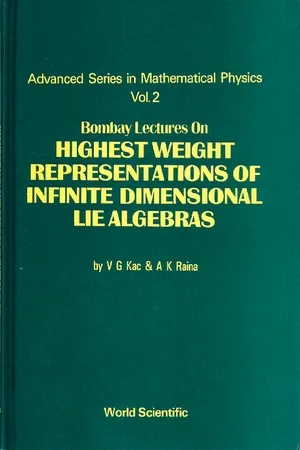
Highest Weight Representations Of Infinite Dimensional Lie Algebra
- 160 pages
- English
- PDF
- Available on iOS & Android
Highest Weight Representations Of Infinite Dimensional Lie Algebra
About this book
This book is a collection of a series of lectures given by Prof. V Kac at Tata Institute, India in Dec '85 and Jan '86. These lectures focus on the idea of a highest weight representation, which goes through four different incarnations.The first is the canonical commutation relations of the infinite-dimensional Heisenberg Algebra (= oscillator algebra). The second is the highest weight representations of the Lie algebra gl? of infinite matrices, along with their applications to the theory of soliton equations, discovered by Sato and Date, Jimbo, Kashiwara and Miwa. The third is the unitary highest weight representations of the current (= affine Kac-Moody) algebras. These algebras appear in the lectures twice, in the reduction theory of soliton equations (KP ? KdV) and in the Sugawara construction as the main tool in the study of the fourth incarnation of the main idea, the theory of the highest weight representations of the Virasoro algebra.This book should be very useful for both mathematicians and physicists. To mathematicians, it illustrates the interaction of the key ideas of the representation theory of infinite-dimensional Lie algebras; and to physicists, this theory is turning into an important component of such domains of theoretical physics as soliton theory, theory of two-dimensional statistical models, and string theory.
Frequently asked questions
- Essential is ideal for learners and professionals who enjoy exploring a wide range of subjects. Access the Essential Library with 800,000+ trusted titles and best-sellers across business, personal growth, and the humanities. Includes unlimited reading time and Standard Read Aloud voice.
- Complete: Perfect for advanced learners and researchers needing full, unrestricted access. Unlock 1.4M+ books across hundreds of subjects, including academic and specialized titles. The Complete Plan also includes advanced features like Premium Read Aloud and Research Assistant.
Please note we cannot support devices running on iOS 13 and Android 7 or earlier. Learn more about using the app.
Information
Table of contents
- Contents
- Preface
- Lecture 1
- Lecture 2
- Lecture 3
- Lecture 4
- Lecture 5
- Lecture 6
- Lecture 7
- Lecture 8
- Lecture 9
- Lecture 10
- Lecture 11
- Lecture 12
- References